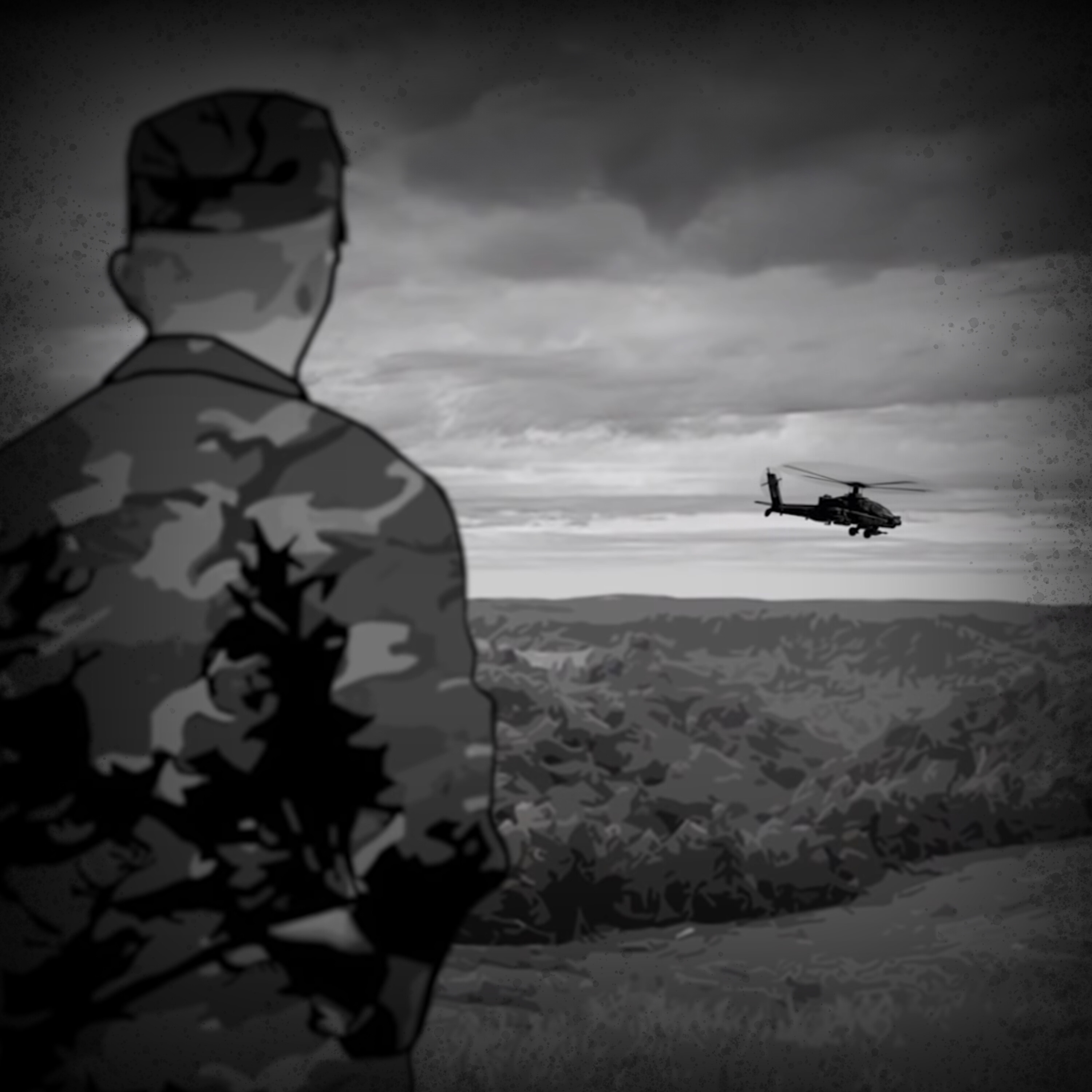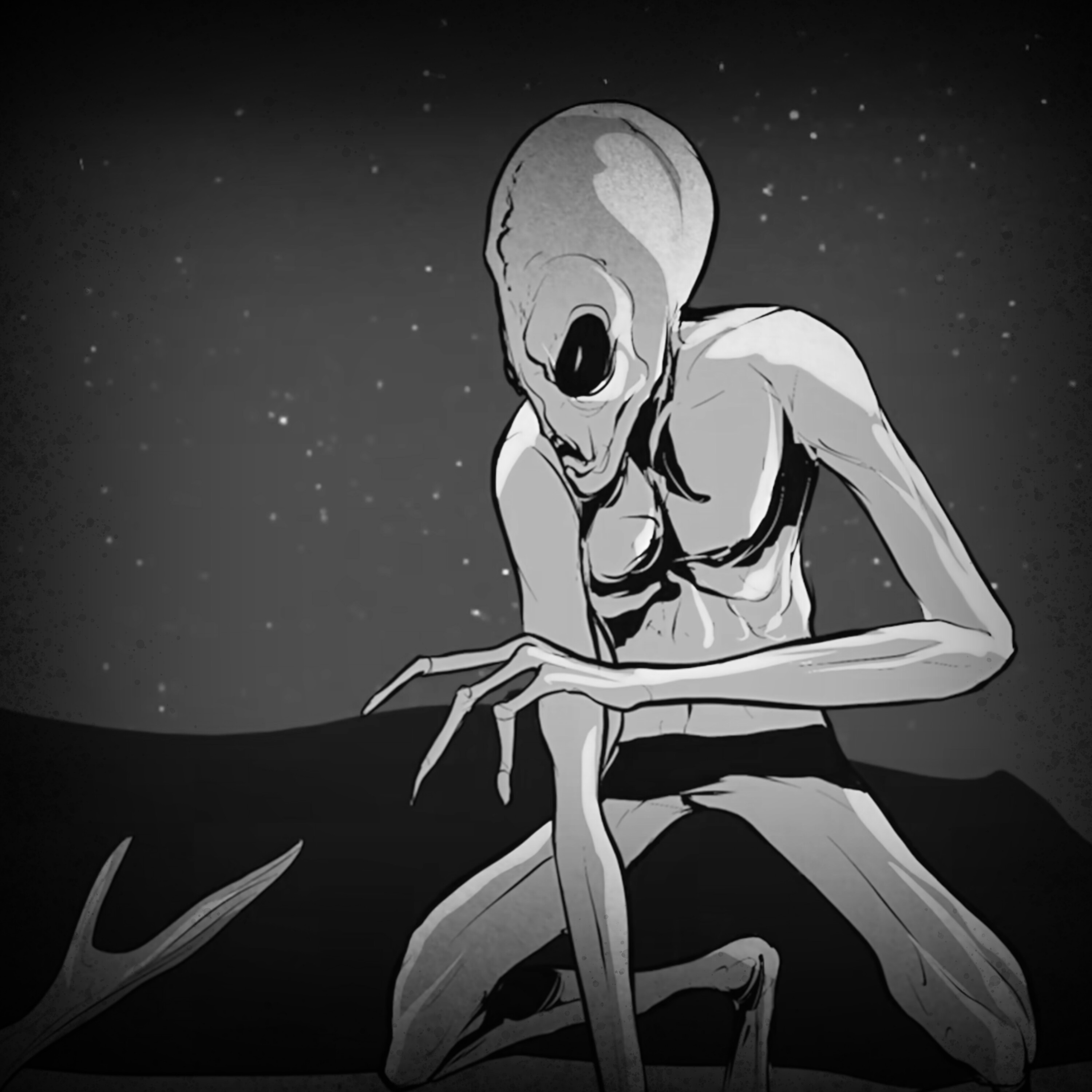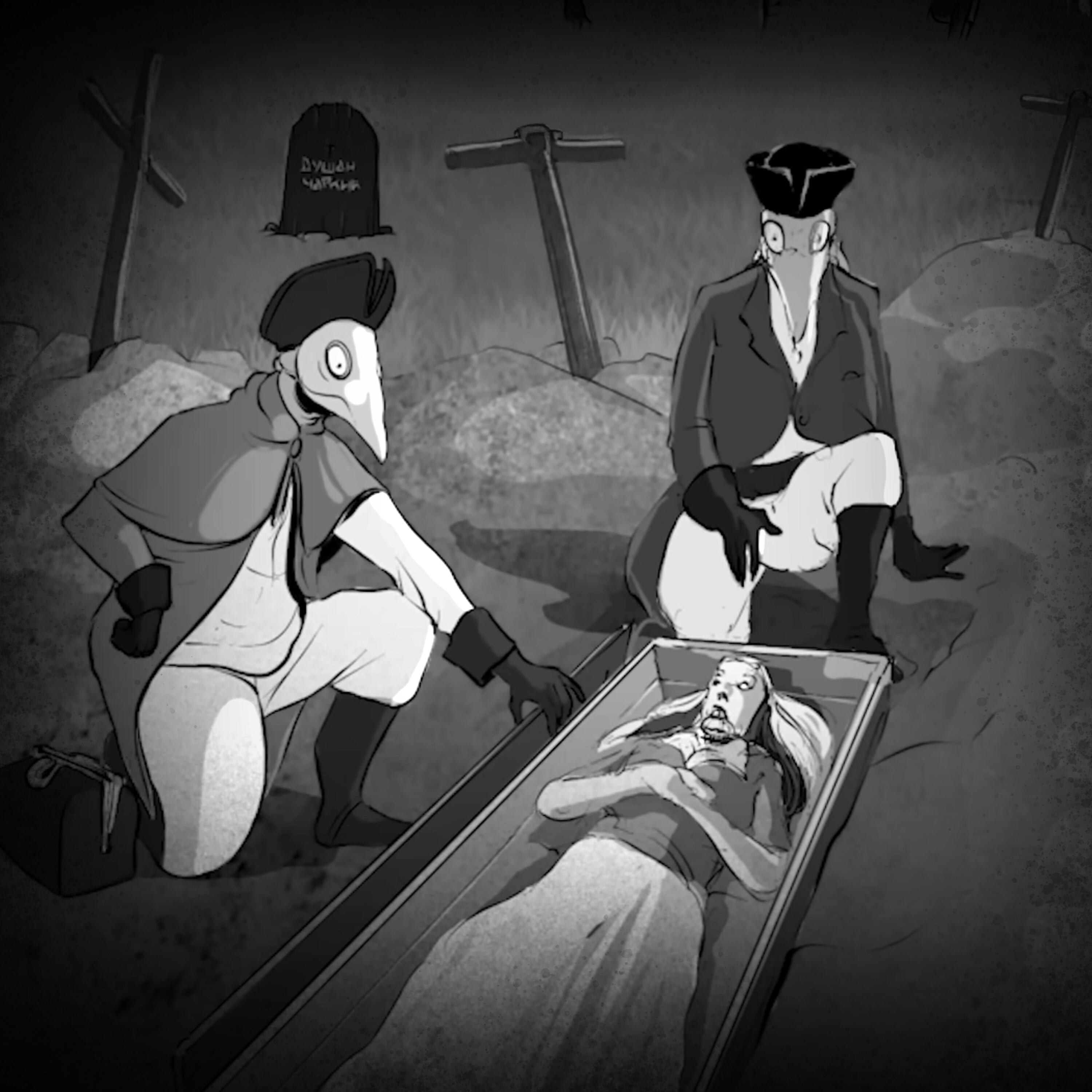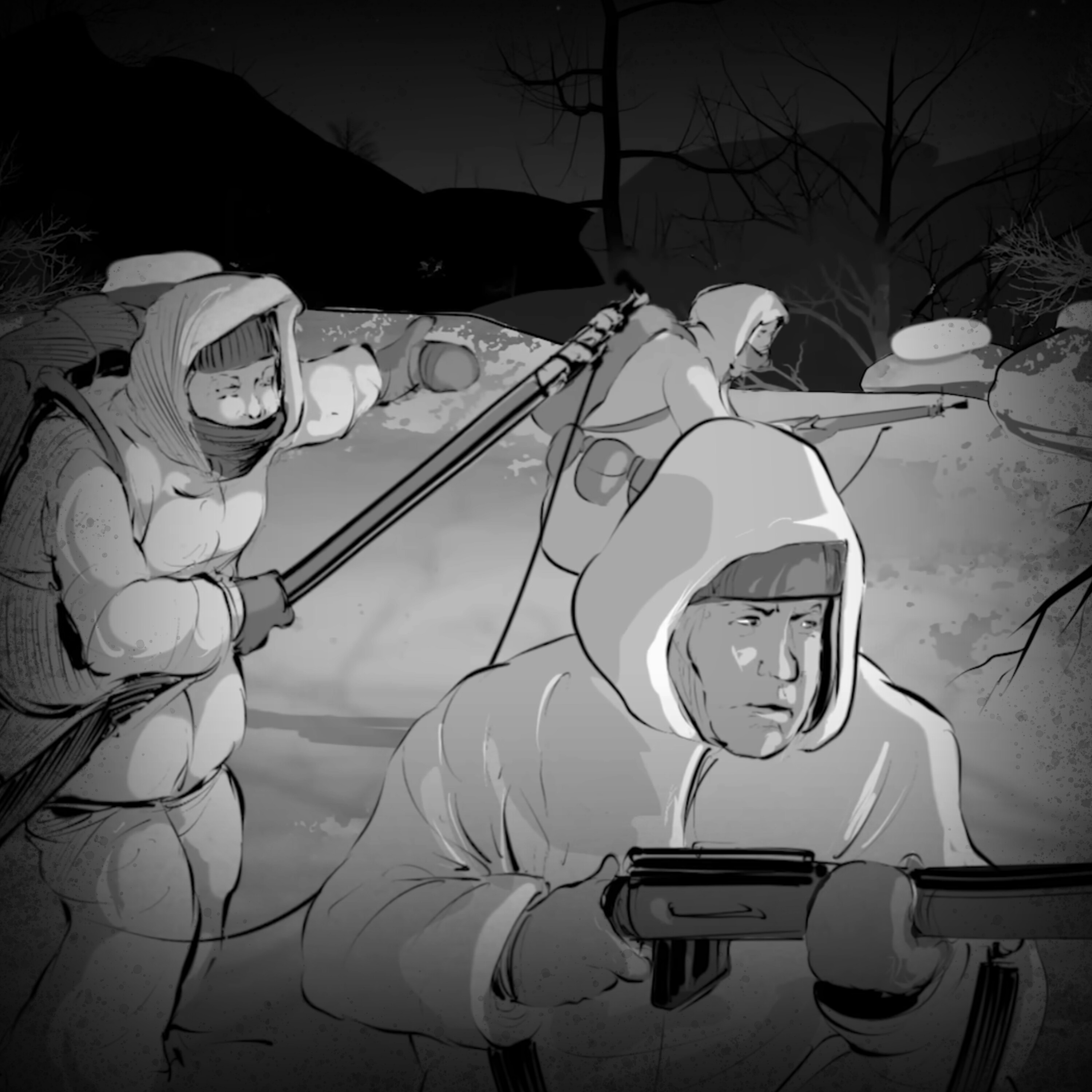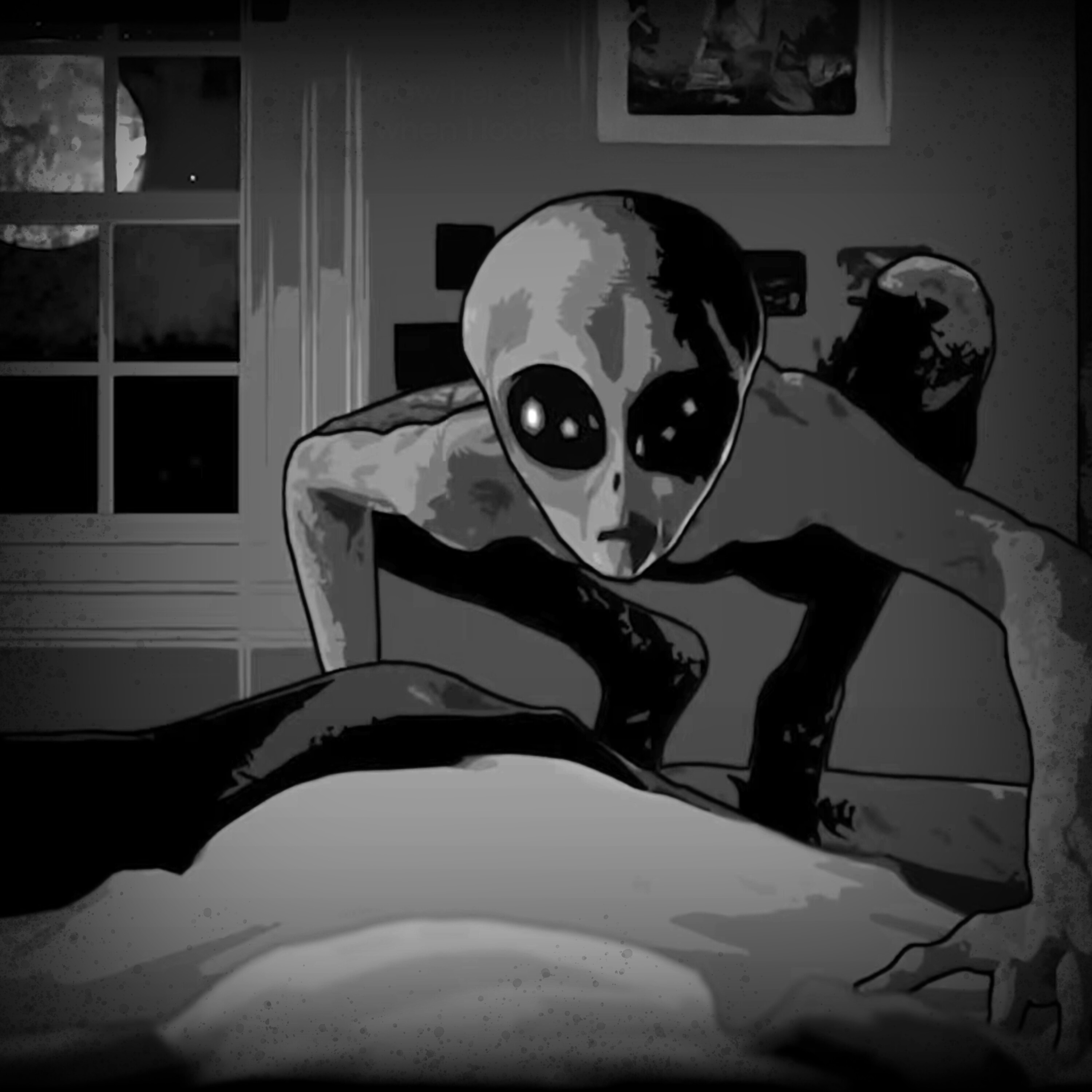The Apache
A soldier recounts a strange encounter during his time at Fort Campbell.
See Privacy Policy at https://art19.com/privacy and California Privacy Notice at https://art19.com/privacy#do-not-sell-my-info.
Press play and read along
Transcript
Speaker 1 If you're drawn to stories like wartime stories, you'll enjoy exploring more from Ballin Studios and Wondery, like my other podcast, Redacted Declassified Mysteries.
Speaker 1 Both shows are available early and ad-free on Wondery Plus. Start your free trial today.
Speaker 2 The WNBA playoffs are on the horizon, and Tommy Alter's The Young Man in the Three takes you deeper into the action.
Speaker 2 Join Tommy for exclusive WNBA Insights as he links up with the league's biggest stars and dives deep into WNBA playoff matchups and analysis you won't hear anywhere else.
Speaker 2 The Young Man in the Three's WNBA playoff coverage is presented by Quest Nutrition. From irresistibly crunchy protein chips to rich chocolatey protein bars, these treats make giving in feel so good.
Speaker 2 Quest, big on protein, low on sugar, huge on flavor. Shop Quest on Amazon at amazon.com slash QuestNutrition.
Speaker 2 And check out all the WNBA action on the Young Man and the Three, wherever you get your podcasts.
Speaker 3 At Designer Shoe Warehouse, we believe that shoes are an important part of, well, everything.
Speaker 4 From first steps to first dates, from all-nighters to all-time personal bests.
Speaker 3 From building teleforts to building a light.
Speaker 4 For all the big and small moments that make up your whole world, DSW.
Speaker 3 DSW is there.
Speaker 4 And we've got just the shoes. Find a shoe for every you from brands you love at bragworthy prices at your DSW store or dsw.com.
Speaker 3 Regardless of how anyone feels about it, the United States government is rather big on keeping secrets. Sometimes these secrets are intended to protect the American public and its interests.
Speaker 3 In any case, there are certainly many things that the government is involved with that are never intended to be made known to the general public.
Speaker 3 As a soldier in the U.S. Army, I would come to discover that being in the military puts a man that much closer to stumbling across something that
Speaker 3 he was never supposed to.
Speaker 3 This is part two of the story of the night shift at Fort Campbell.
Speaker 3 I'm Luke Lamana,
Speaker 1 and this is Wartime Stories.
Speaker 3 My days and nights while stationed at Fort Campbell were a great time for me. To say the very least, those 23 months were the most interesting part of my life.
Speaker 3 I say interesting because although my primary occupation was in communications, I was temporarily transferred to the Military Police Division to work as a security guard.
Speaker 3 Since fixing broken antennas, radios, and other comm gear was far from exciting, I very much enjoyed doing those daytime and nighttime security patrols along the mostly quiet back roads and secluded areas in and around the large base.
Speaker 3 However, I did have more than a couple, what I would call, strange encounters during the conduct of these patrols.
Speaker 3 One of these encounters wasn't anything you might consider highly unusual,
Speaker 3 or maybe it was.
Speaker 3 I mean no disrespect by saying that I am well aware that our government has plenty of secrets.
Speaker 3 The world is full of unseen dangers and there are of course some things that are best kept under wraps in the interest of protecting not only Americans, but those countries with which we are allies.
Speaker 3 I'll give you an example. One of the biggest secrets maintained by the United States government was to conceal an entire American city from the outside world, even from fellow Americans.
Speaker 3 The city is called Oak Ridge, Tennessee, and it's actually just a few hours' drive east of Fort Campbell.
Speaker 3 For those who don't know its extraordinary history, the U.S. government built the entire city of Oak Ridge in just a matter of months back in the 1940s.
Speaker 3 It was intentionally hidden, tucked away inside 60,000 acres of land purchased in the undeveloped and isolated back woods of Tennessee.
Speaker 3 The entire city, everything right down to the city streets, stoplights, and sewers, was planned and constructed by the U.S. government to house one specific group of people.
Speaker 3 These were the tens of thousands of civilian personnel, along with their families, who were secretly relocated at Oak Ridge to accomplish one goal.
Speaker 3 to acquire and prepare the materials needed to manufacture the newly developed atomic bomb. The year was 1942.
Speaker 3 The A-bomb was a new wonder weapon of mass destruction, and it was going to end the war, if not tragically.
Speaker 3 During World War II, the city of Oak Ridge was a vital part of the then top-secret Manhattan Project.
Speaker 3 As such, its very existence was kept hidden from the outside world. It wasn't even listed on maps for several years, not until after the war was over.
Speaker 3 Now, imagine how hard it is to keep an entire city a secret like that. What would happen, hypothetically, if some random hiker got lost and stumbled into the town? I have no idea.
Speaker 3 But if a private citizen learns about a government secret like that, it's probably a big surprise for him. A person might have a hard time keeping quiet about it.
Speaker 3 And if a secret that big gets out, the rest of the world would soon know everything about it.
Speaker 3 You can only imagine the potential consequences of Oak Ridge being discovered, the damage to the Manhattan Project, and the impact it would have had on the war.
Speaker 3 So you can probably also imagine the lengths to which the U.S. government went to keep it from being discovered.
Speaker 3 Let's just say I personally wouldn't want to be that random hiker.
Speaker 3 But unlike a civilian, if a person in the military, like myself, happens to stumble across something top secret, they at least understand it could be damaging to national security and certainly to their own career to talk about it.
Speaker 3 So they are more inclined not to do so.
Speaker 3 Again, I tell you this because when I I was in the Army, stationed on Fort Campbell, there was a time when I thought me and my buddy, whom I'll just identify as Corporal Lack,
Speaker 3 might have stumbled across something like that. Something that we weren't supposed to have seen.
Speaker 3 Now, something you should know about Lack. Overall, he was a good soldier, professional, easygoing, and he had a good sense of humor when it was appropriate.
Speaker 3 You pretty much couldn't help but like him.
Speaker 3 But Lack also had a habit of being a little too serious at times, and one night in February of 1988,
Speaker 3 it put both of us in a very bad position.
Speaker 3 Nearly got both of us killed, in fact.
Speaker 3 Bravo 4-7, this is Command. Command over.
Speaker 3 This is Bravo 4-7. Send it.
Speaker 3 What's your current location?
Speaker 3 One cold night in February, while we were conducting our routine patrol around Fort Campbell, Lack and I received an unexpected radio call.
Speaker 3 Our dispatch informed us that they'd been contacted by the nearby dispatch center, a Clarksville Police Department, because they'd received a 911 call about a possible crash of a small civilian plane, someone having spotted it flying low, over the base's southern fence line.
Speaker 3 Since the caller said they thought that the plane had crashed on the base, the local civilian police couldn't conduct the initial investigation, so they called the base police.
Speaker 3 Lack and I were patrolling in that general vicinity of the base, so we were assigned to search the area where the caller believed the plane may have gone down.
Speaker 3 We were somewhat skeptical. Planes don't exactly crash every day.
Speaker 3 So as we drove around the area, we didn't really expect to find anything.
Speaker 3 This area of the base was less heavily forested, having some open patches of land scattered alongside the roads.
Speaker 3 After a bit of slow driving in the dark, shining the truck spotlights along the tree lines as we went, we suddenly saw what indeed appeared to be a crash site in one of these open fields.
Speaker 3 Getting out of the truck with our flashlights, we walked quickly, although very carefully, towards the wreckage, shining our lights around, trying not to step on any of the countless pieces of wreckage and debris.
Speaker 3 In hindsight, I maybe should have radioed our dispatch right away, before leaving the truck, to confirm that we had found a downed aircraft.
Speaker 3 But in the heavy darkness, I suppose we were curious and wanted to confirm what it was before reporting it, as well as to check for survivors in need of help.
Speaker 3 The pile of wreckage was billowing some steam, which was quite visible in the beams of our flashlights.
Speaker 3 The main fuselage lay among scattered debris, sitting in the middle of the field, about 75 yards from the road, about the same distance from the tree line behind it.
Speaker 3 As we got closer to the main body of the aircraft, we were shocked to realize that these were not the remains of a civilian plane.
Speaker 3 It was one of our own Apache attack helicopters, or rather, it was what was left of one.
Speaker 3 Unable to detect the smell of spilt fuel, nor seeing any indication it might catch fire, we kept approaching it, hoping again to first check for any survivors, although the general appearance of the crash site didn't seem hopeful.
Speaker 3 The ground showed a significant crater at its initial point of impact.
Speaker 3 Pieces of the helicopter were clearly buried in it, with a length of other impact points and bits of debris strewn along the ground in front of it, a number of detached rockets also laying scattered around the clearing.
Speaker 3 These additional craters indicated that it had likely bounced after its first impact, then flipping or rolling a number of times before coming to a stop.
Speaker 3 Now the broken and twisted heap of metal that lay before us.
Speaker 3 Scanning the tree line behind it with our flashlights, it was a section of trees whose tops were noticeably damaged.
Speaker 3 Considering the 911 call about a low-flying aircraft, we figured that the helicopter must have clipped the treetops at a fast speed, which caused it to crash as hard and as abruptly as it did.
Speaker 3 The pilot probably had little or no time to react.
Speaker 3 The damage to the Apache, including its cockpit, was extensive. Seeing this, we knew then that there was little chance of either of the two pilots having survived.
Speaker 3 I told Lack to check the cockpit anyway before I jogged back to our truck, carefully avoiding the debris so I could radio back a report on the crash.
Speaker 3 And that was when this strange situation
Speaker 3 got even stranger.
Speaker 5 Big moments or small moments? They all deserve great style. At Maurice's, we're here to help you show up feeling your best, no matter what's on your calendar.
Speaker 5 Whether it's a date night, a special event, or just another Tuesday. Our over 800 stylists are here to help.
Speaker 5 From tried and true denim to head-turning looks, we've got style that fits your life and your budget. Visit your local Maurice's to find fashion fit for you with a little help from us.
Speaker 6 Looking for an electric SUV that doesn't compromise on space? Meet the all-new 2026 Ionic 9, Hyundai's first three-row all-electric EV, space in an EV.
Speaker 6 Finally, with an impressive 335-mile range, this isn't your typical EV.
Speaker 6 Go further with up to an estimated 150 miles of charge in just 15 minutes on the Ionic RWD9S when using a 350 kilowatt DC ultra-fast charger and CCS adapter. Actual charge time may vary.
Speaker 6 Plus, with glass-leading interior space, seven high-powered USB-C ports, and advanced features like highway driving assist 2, every journey is seamless.
Speaker 6
And for peace of mind, there's a 10-year 100,000-mile battery warranty. Ready to explore more? Learn more about the IONIC 9 at HyundaiUSA.com.
Call 562-314-4603 for complete details.
Speaker 3 This is Bravo 47 calling command. Come in over.
Speaker 3 Command of Bravo 47. Go ahead.
Speaker 3 We are currently at
Speaker 3 What the hell?
Speaker 3 Command, this is Bravo 4-7. You read me?
Speaker 3 Huh.
Speaker 3 Well, that's weird.
Speaker 3 Come on.
Speaker 3 Command, this is Bravo 4-7. Command over.
Speaker 3 Right after my dispatch acknowledged my call-in, my transmission was suddenly drowned out by some kind of radio interference. A distinct electronic hum was the only thing I could hear.
Speaker 3 I clicked through the radio, trying a few other channels, but the same interference seemed to be preventing me from transmitting on those as well.
Speaker 3 Being my primary MOS was communications, I suspected, shall I say strongly suspected, that this wasn't just some kind of random interference with our radio. I had certainly never heard it before.
Speaker 3 I knew enough about radio signals to know when something strange was happening. Here I'll give you an example.
Speaker 3 If you're ever driving down the road and listening to your car's radio, specifically AM radio, and you pass by some overhead power lines, you'll notice the radio signal will often either get fuzzy or be completely drowned out by static.
Speaker 3 That interference is caused by the electromagnetic energy coming off the high voltage power lines.
Speaker 3 However, out here in this empty field on Fort Campbell, there were no power lines. or any other reasons for this kind of sudden and very powerful radio interference.
Speaker 3 I had no idea why, but it seemed very possible that the designated radio frequencies we were using were intentionally being jammed on all available channels no less.
Speaker 3 Unable to send up a report, I impatiently tossed the radio handset onto the front seat.
Speaker 3 I then reached into the cargo area of the truck, grabbing a fire extinguisher, before jogging back over to the wreckage.
Speaker 3 Black was now standing right beside the airframe, staring at the pilot, who was still strapped to the rear seat, plainly visible through what little remained of the chopper's canopy.
Speaker 3 Starting to open my mouth, wanting to tell Lack about the issue with the radio, I suddenly stopped, my attention being drawn back to the pilot.
Speaker 3 He wasn't wearing the right uniform.
Speaker 3 In my experience, American pilots would normally have worn an olive-green one-piece sipred flight suit.
Speaker 3 This man was wearing something that looked much more like the older Vietnam-era fatigues, OD green, with large buttons down the front of the blouse, the jacket.
Speaker 3 Shining my flashlight from various angles, looking for any other identifying markings, I then saw the patch of a foreign flag sewn onto his upper sleeve. My suspicions were confirmed.
Speaker 3 Having deployed to Central America myself, if only for a few weeks, I thought I had recognized the uniform he was wearing. A Honduran Army uniform.
Speaker 3 Very much out of place on someone piloting an American helicopter, I thought.
Speaker 3 He was wearing the right headgear though, a pilot's helmet, which was equipped with its rather obvious integrated night vision hardware and target acquisition display.
Speaker 3 He was also very clearly dead.
Speaker 3 No surprise to us though. We figured there was little chance of either the pilot or the gunner having survived a crash this bad.
Speaker 3 The nose of the helicopter having been practically obliterated on impact.
Speaker 3 The front part of the aircraft where the gunner would have been seated was just gone.
Speaker 3 If there had been two men in that helicopter, you wouldn't know it by looking at it.
Speaker 3 Looking back at Lack, who looked as confused as I was, I suddenly remembered the issue with the radio and told him about it.
Speaker 3 Not sure what else to do, we continued carefully walking around the wreckage, looking for anything else unusual while discussing what our best course of action was, what was not being able to communicate anything back to our command.
Speaker 3 Having a fire extinguisher on hand, we figured at least one of us should stay close to the wreckage, in case it caught fire.
Speaker 3 Being able to stop a fire as soon as it started might help preserve something important for whoever would end up investigating the crash.
Speaker 3 Suddenly, we heard the sound of vehicles approaching, soon followed by headlights on the nearby road.
Speaker 3 Now,
Speaker 3 things got even stranger.
Speaker 3 Two Humvees in an M35 troop transport truck sped up to the clearing, stopping abruptly. A dozen or so soldiers wearing black uniforms, very unusual, quickly filed out of the back of the deuce.
Speaker 3 They swiftly approached the wreckage, scanning the area, the two of us included, their M16s out and ready.
Speaker 3 Very odd behavior for investigating a crash site like this, I thought.
Speaker 3 Especially, as they kept pointing loaded rifles at what were clearly two fellow soldiers.
Speaker 3 None None of them wore any divisional insignia nor had any name tags on their uniforms. They wore only a subdued patch of the American flag on their sleeve.
Speaker 3 One of them did have sergeants' bars on his collar and another had a corporal's, but the others had no rank identifiers whatsoever.
Speaker 3 A colonel, a lieutenant colonel, and two majors then got out of the Humvees, identifiable by the rank they wore on their collars. But none of them had any divisional insignia or name tags either.
Speaker 3 As they approached us, still standing next to the wreckage, four soldiers from the larger group walked over and joined them.
Speaker 3 The colonel suddenly pointed at us and shouted, you will leave now.
Speaker 3 Remember when I said Lack had a bad habit of taking his job too seriously?
Speaker 3 This is one of those times.
Speaker 3 He got, if you will, all formal and by the book.
Speaker 3 He firmly told the colonel that we were not leaving the area until we were properly relieved, according to the rules and regulations and all that
Speaker 3 well the colonel was clearly not happy with his response by the look on his face his two-second fuse was already halfway burnt
Speaker 3 personally i felt that the regulations on this were pretty clear and obvious the colonel was very much our superior officer and he'd given us direct orders to leave I was fine with obeying those orders and leaving right then and there.
Speaker 3 But for the life of me, I don't know what Lack was thinking.
Speaker 3 And I certainly did not expect what happened next.
Speaker 3 The colonel turned to one of the blacked-out soldiers, one wearing sergeant's bars, and very clearly said,
Speaker 3 Sergeant, if they are not gone in 30 seconds,
Speaker 3 kill them.
Speaker 3 He then turned back to face Lack as he continued his instructions to the sergeant.
Speaker 3 And dispose of their bodies along with that.
Speaker 3 He was pointing at the wrecked Apache.
Speaker 3 Sergeant No Name then stepped forward and brought his M16 up to shoulder, pointing it directly at Lack's chest.
Speaker 3 Now,
Speaker 3 I'm not a very good poker player, but I sure as hell know when I need to fold my hand and walk away from the table.
Speaker 3 I quickly turned and walked back towards our truck. I didn't say a word.
Speaker 3 I got into the driver's seat, started the engine, held my foot down on the brake, and put it in gear.
Speaker 3 I kept staring straight ahead at the road, praying that Lack would wise up and get in the damn truck.
Speaker 3 Thankfully, he was climbing into the passenger seat about three seconds later, having evidently changed his mindset.
Speaker 3 Keeping my eyes straight ahead, I immediately drove us the hell out of there.
Speaker 3 Bravo 47, this is command. Come in over.
Speaker 3 After a time, having forgotten all about the radio, it suddenly barked back to life, startling me. I hadn't even realized that the electronic hum had stopped.
Speaker 3 Dispatch was calling us, asking if we were okay.
Speaker 3 As calmly as I could, I replied that we were fine.
Speaker 3 They asked what I had attempted to say in my initial radio transmission before the strange interference had started up.
Speaker 3 With some hesitation, I replied that we hadn't found anything yet and that we planned on continuing our search of the area.
Speaker 3 Several hours later, when we got back to the station at the end of our shift, our shift commander pulled us into his office.
Speaker 3 In what I thought was something of a tentative manner, he asked us if we had ended up finding anything during our search of the woods.
Speaker 3 As I have previously indicated, this wasn't my first rodeo. I've been down this road before, and I knew full well that silence is golden.
Speaker 3 Clearing my throat, looking first at Lack, then back at the shift commander, I quietly said that, no, sir, we hadn't seen anything out there. Nothing unusual to report.
Speaker 3 Black seemed like he was about to say something, but then he simply nodded and said the same thing.
Speaker 3 Nothing unusual.
Speaker 3 We all just stood silently in his office for a moment.
Speaker 3 Commander seemed rather pleased by our replies.
Speaker 3 I could swear by the look of relief on his face, he knew more. than what he was either willing or able to tell us.
Speaker 3 He then dismissed us, and I was very relieved to be dismissed.
Speaker 3 I left the station, and Black did too.
Speaker 3 I don't even think I stopped anywhere to get anything to eat on my way home. I simply drove back to my tiny base apartment and sat in the dark in my tiny living room.
Speaker 3 The night's events raced through my mind. I wondered why things like this had to happen to me.
Speaker 3 I couldn't come up with an answer, so finally,
Speaker 3 I went to bed.
Speaker 3 We never heard anything about any civilian plane crash. I never asked anyone about it either.
Speaker 3 For a good number of years afterward, I would find myself lost in thought, wondering if that colonel was bluffing, or if he really would have had Lack and me killed if we had chosen not to leave the crash site.
Speaker 3 Some years beyond that, after I got married and started a family, now having my own children, I began to question what became of the bodies of the two men who died in that helicopter crash.
Speaker 3 Where were their final resting places? What were their families told?
Speaker 3 Or did their remains in that Apache helicopter simply vanish into the void of yet another classified government secret?
Speaker 3 As for why a Honduran soldier was sitting in the pilot's seat, I may be able to offer you some amount of explanation.
Speaker 3 I would come to learn that at that time, the Apache was being used to secretly train foreign pilots to fly U.S. military helicopters and for a specific reason.
Speaker 3 On March 17, 1988, only a month after the night we discovered that crashed Apache, thousands of U.S.
Speaker 3 military personnel, some from the 82nd Airborne Division, deployed into Honduras in support of Operation Golden Pheasant.
Speaker 3 As I have alluded to already, I was also deployed to Honduras, but that was in December of 1986, more than a year before this official operation began.
Speaker 3 My group was assisting with the construction of an airfield, likely to prepare for the upcoming airborne operations.
Speaker 3 Like the recent war in Vietnam, during my time in the 80s, the U.S. international policy preventing the spread of communism was still in effect in Central America.
Speaker 3 As with local anti-communist groups who had fought in Vietnam, following an overthrow of the Nicaraguan government in 1979, the U.S. was now back in the anti-communists in Nicaragua.
Speaker 3 In this case, it was the Contras in their fight against the newly established Marxist and reportedly Soviet-funded government, the Sandinistas.
Speaker 3 Operation Golden Pheasant was billed as an emergency deployment readiness exercise, a simple joint training exercise between the U.S. and Honduran militaries.
Speaker 3 But our soldiers were evidently deployed ready to fight, not only to conduct training.
Speaker 3 The rumor was that the Sandinistas had been illegally operating in Honduras, and that the American troops were sent to push them back out.
Speaker 3 However, Pentagon officials assured the public that our troops would be staying well away from the border where the U.S.-backed Contra rebels had reportedly been fighting with the Sandinistas.
Speaker 3
Whatever the true events were, following this rapid deployment of U.S. troops into Honduras in March, the Sandinistas quickly withdrew, and the U.S.
troops would pull back out by the end of the month.
Speaker 3
Ultimately, though, the U.S. government's support and funding of the Contras was frowned on by many Americans.
When it was discovered that the U.S.
Speaker 3 government had been covertly selling arms through Iran to bypass congressional approval, it sparked a rather nasty political controversy back in the late 80s.
Speaker 3 Such is the result of the uncovering of government and military secrets.
Speaker 3
Wartime Stories is created and hosted by me, Luke Lamana. Executive produced by Mr.
Ballin, Nick Witters, and Zach Levitt. Written by Jake Howard and myself.
Speaker 3
Audio editing and sound design by me, Cole Acascio, and Whitlacascio. Additional editing by Davin Intag and Jordan Stiddum.
Research by me, Jake Howard, Evan Beamer, and Camille Callahan.
Speaker 3
Mixed and mastered by Brendan Kane. Production supervision by Jeremy Bone.
Production coordination by Avery Siegel. Additional production support by Brooke Lynn Gooden.
Speaker 3 Artwork by Jessica Clogson-Kiner, Robin Vane, and Picada. If you'd like to get in touch or share your own story, you can email me at info at wartime stories.com.
Speaker 3 Thank you so much for listening to Wartime Stories.
Speaker 1 As many of you know, Mr. Balin and Balin Studios have been a huge help in bringing this podcast to life.
Speaker 1
And if you'd like to believe you are something of a storytelling connoisseur, then you need to check out Mr. Balin's podcast, Strange, Dark, and Mysterious.
Each week, Mr.
Speaker 1 Balin weaves gripping tales of the Strange, Dark, and Mysterious, diving into true crime, unsolved mysteries, and paranormal events that keep you on the edge of your seat. Mr.
Speaker 1 Balin's podcast, Strange, Dark, and Mysterious, is available on all podcast platforms and it is free, just like ours.
Speaker 1
There are hundreds of episodes available to binge right now with new episodes twice a week. Go listen to the Mr.
Balin podcast today.
